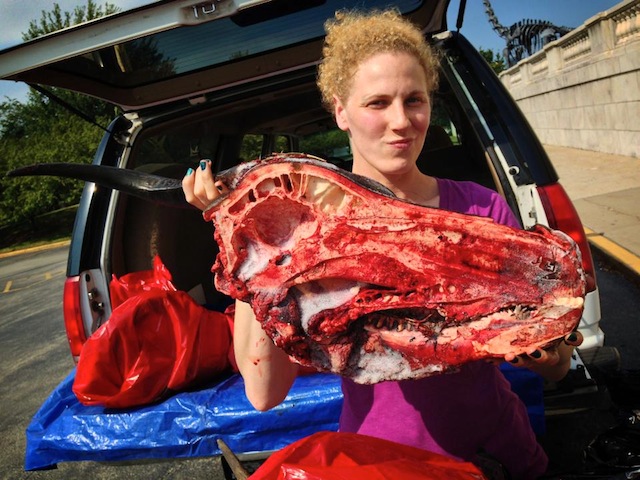Ask A Scientist, Bare Bones Edition: Anna Goldman
By Marielle Shaw in Arts & Entertainment on Dec 18, 2014 7:00PM

Anna Goldman shows off a bisected forest buffalo head.
It's "Ask a Scientist" time again, fellow science fans! Last month, we talked all about bugs with Corrie Moreau, the Field Museum's Associate Curator in the Integrative Research Center (Insects). She was kind enough to tell us how to combat hordes of fruit flies, where to find interesting ants, how to help monarch butterflies and reminding us that spiders were our friends.
Next on our list of amazing scientists working at the Field is another wonderful woman of science, Anna Goldman. She is the Field Museum's Assistant Collections Manager and a Mammals Preparator.
Part of Anna's job at the museum is to prepare specimens for collections. That sounds clinical enough, but when you get down to it, it's all about skin, bones and guts. And her helpers and tenants are the museum's colony of dermestid beetles, who help to de-flesh the many different specimens used for research and display.
So stow the head cheese and grab a beverage while we let Anna take it from here and flesh out what she does. Enjoy, and as always, start gathering questions you'd like Anna to answer!
CHICAGOIST: How long have you been with The Field Museum?
ANNA GOLDMAN:: Ten years.
C: What does your job entail?
ANNA GOLDMAN: My job entails preserving mammal specimens for museum collections with techniques that have been refined for centuries. Yes, this means I skin, gut and stuff dead mammals. That is the main part of my job. But I also manage the dermestid beetle colony, who help clean the flesh off the bones.
C: How did you get into your field of research?
ANNA GOLDMAN: Pure interest. I brought a chewed on, furry deer leg in for show and tell in third grade. I was incredibly interested in anatomy, physiology and
decomposition. However, I got my introduction to science through bugs. That is actually how I started at The Field Museum, in their insect collection as an intern. When I was about eight, I fell in love with mosquitoes while away at summer camp. I was curious about their behavior and feeding strategies. After that, it was set. I read loads of bug books and started to plan my future. Then came college, where I could study insects and also have the opportunity to skin mammals, often, never imagining that it could possibly ever be my job. So after graduating, when this position opened up, I jumped on it, not knowing it was my dream come true. Bugs and mammals? Yeah, I'm the luckiest girl around.
C: What's your favorite specimen at The Field Museum?

Anna Goldman with one of her favorite specimens, a dolphin skull. (Photo credit: Daniel Le)
They have two nasal passages just like we do, with the same bones between the nose and teeth, but theirs is further up, closer to where their forehead may be. On top of that, they have one nasal passage that is smaller than the other. Mammals have bilateral symmetry but when it comes to nasal passages, marine mammals don’t! The theory is that it helps with gas exchange under high pressure. Every time I talk about it my heart races and I get so excited. it’s a great example of change over time.
Granted, we can’t just throw our kids into the ocean and expect to watch them adapt. There were, I am sure, many failed attempts at adapting in water from land. But here is a success story!
C: What are you working on today?
ANNA GOLDMAN: Today and all week I have been working on getting the right feeding schedule for the dermestid beetles. In the summer, they are very busy, hungry and active. At some point in the fall, they slow down drastically and stop eating as much. If I put a large specimen in there, it will just sit for weeks, getting slowly munched on. If I put a few small things in there, they will be more efficient. Right now I am reducing the size of the specimens in the tank and making sure they are hydrated by misting a little water here and there.
We'd like to thank Anna for participating in Ask a Scientist, and encourage you to send her some questions while you're on your holiday break. Want to know how long it takes for the beetles to eat something dog-sized? How long they live? Do you have any pressing dolphin questions, or questions about how specimens are prepared? You know what to do. Put it in our comment section below, and we'll get this back to the lab for answers. While you're at it, visit the Field Museum over the holidays, and see some of Anna's work for yourself.